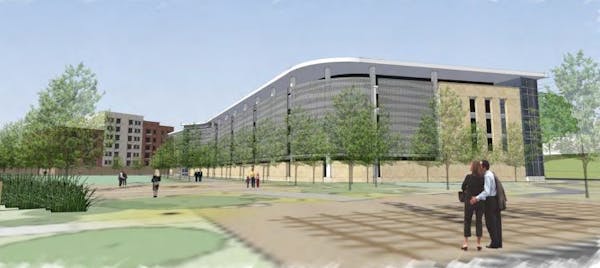An 800-car parking ramp proposed by the Federal Reserve Bank for its riverfront headquarters in downtown Minneapolis is drawing opposition from residential neighbors who fear its impact on traffic and the environment.
The neighbors, who have formed an opposition group called Halt the Ramp, are expected to turn out in force Monday for a public hearing on the proposal at the City Planning Commission meeting.
"Our goal … is to go as a group and respectfully ask the planning commissioners to halt the ramp until we can determine if this is the best use of this property for the city, for the future, for safety," said Nancy Gardner, who began organizing opposition this spring.
Officials in the city's Community Planning and Economic Development Department released a report last week recommending that the Planning Commission reject the site plan and the conditional use permits required to build a five-level parking structure in the district.
Federal Reserve officials, on the other hand, note that the bank is the largest employer in the North Loop and that parking availability has dramatically decreased since the bank opened its doors there in 1997. Many say the need for more parking downtown has grown exponentially over the years.
"In 2015, we started noticing it was becoming more difficult for us to find parking for our employees," said Duane Carter, a senior vice president for the Minneapolis Fed. "Of course, attracting and retaining the talent ... is extremely important."
The five-level garage would be built next to the Fed's headquarters, which are off Hennepin Avenue near the Mississippi River.
The proposed ramp site, which runs just south of the Cedar Lake bike trail, has an existing 300-car ramp often used by Twins fans or for church events. It was purchased last year by the Federal Reserve for $7.5 million, Carter said.
Plans for the new solar-ready ramp include a large public green space. Parking also would be available for the public.
But opponents believe the new ramp would be the wrong move for a city working to reduce greenhouse gas emissions and increase housing.
Gardner cited an analysis of the proposal commissioned by the Fed that showed an increase of about 1,345 car trips per workday if the ramp is built. Traffic mitigation options would likely lead to reduced safety for pedestrians and bicyclists and add greenhouse gases from the reduced speed of cars, according to the study.
That's not in line with the goals outlined in Minneapolis' proposed 2040 Plan, she said.
"We have acknowledged that there's a transportation problem and a parking problem in the North Loop and in Minneapolis. But the way to solve that is not with more parking ramps," Gardner said.
In their report rejecting the site plan, city planning officials wrote that the project conflicts with city regulations "related to building placement, visual interest, windows, ground floor active functions, parking garages, general landscaping and screening and crime prevention through environmental design."
Carter said the proposed ramp is designed in such a way that it could be converted for new uses in the future as fewer residents drive. He said that the Federal Reserve still hopes the Planning Commission will recognize the needs of its employees.
"We're confident that what we're advancing does add great value to the area," Carter said.
Zoë Jackson • 612-673-7112

Minnesota State Patrol celebrates diverse new class of troopers

Records: Former Minneapolis police oversight head disparaged women, threatened staff
Video goes viral of man enduring 'shocking' chain whipping on downtown St. Paul street
Minnesota sales, clean-ups and other events to celebrate Earth Day and Arbor Day

